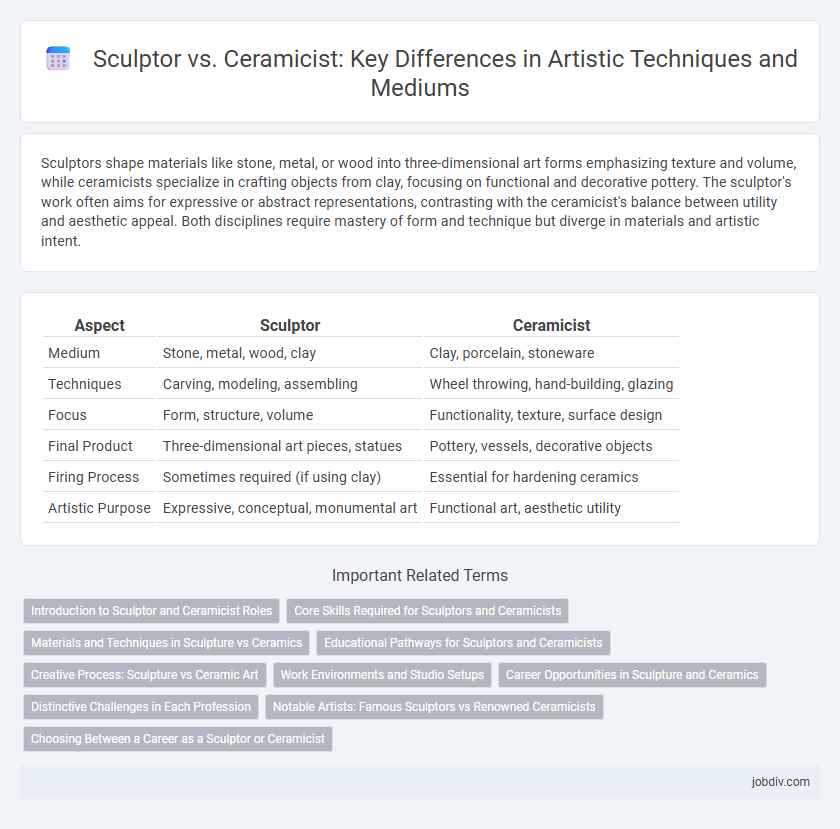Sculptors shape materials like stone, metal, or wood into three-dimensional art forms emphasizing texture and volume, while ceramicists specialize in crafting objects from clay, focusing on functional and decorative pottery. The sculptor's work often aims for expressive or abstract representations, contrasting with the ceramicist's balance between utility and aesthetic appeal. Both disciplines require mastery of form and technique but diverge in materials and artistic intent.
Table of Comparison
| Aspect | Sculptor | Ceramicist |
|---|---|---|
| Medium | Stone, metal, wood, clay | Clay, porcelain, stoneware |
| Techniques | Carving, modeling, assembling | Wheel throwing, hand-building, glazing |
| Focus | Form, structure, volume | Functionality, texture, surface design |
| Final Product | Three-dimensional art pieces, statues | Pottery, vessels, decorative objects |
| Firing Process | Sometimes required (if using clay) | Essential for hardening ceramics |
| Artistic Purpose | Expressive, conceptual, monumental art | Functional art, aesthetic utility |
Introduction to Sculptor and Ceramicist Roles
Sculptors shape materials such as stone, metal, or wood to create three-dimensional artworks that emphasize form and spatial relationships. Ceramicists specialize in crafting objects from clay, combining artistry with technical knowledge of kiln firing and glaze chemistry to produce functional and decorative pieces. Both roles demand creativity and mastery of specific techniques but diverge in materials and finished forms.
Core Skills Required for Sculptors and Ceramicists
Sculptors require advanced skills in anatomy, spatial awareness, and material manipulation to create three-dimensional forms from materials such as stone, metal, or wood. Ceramicists excel in techniques like wheel throwing, hand-building, glazing, and kiln-firing, emphasizing precision in clay preparation and surface finishing. Both disciplines demand creativity and a strong understanding of their respective materials' physical properties to achieve durability and aesthetic appeal.
Materials and Techniques in Sculpture vs Ceramics
Sculptors typically work with materials such as stone, metal, wood, and clay, employing techniques like carving, casting, and assembling to create three-dimensional forms. Ceramicists focus on clay and other earthen materials, using methods like hand-building, wheel-throwing, and glazing to produce both functional and decorative objects. The key distinction lies in the sculptor's broader material range and emphasis on structural form, while ceramicists concentrate on clay manipulation and surface finishes.
Educational Pathways for Sculptors and Ceramicists
Sculptors typically pursue formal education through fine arts programs, often earning a Bachelor of Fine Arts (BFA) or Master of Fine Arts (MFA) with a focus on sculpture techniques, materials, and art history. Ceramicists usually study ceramics or pottery in specialized art schools or colleges, where they learn wheel throwing, glazing, and kiln firing processes alongside creative design principles. Both pathways emphasize hands-on studio work, critical feedback, and the development of a unique artistic style through dedicated practice and mentorship.
Creative Process: Sculpture vs Ceramic Art
Sculptors primarily manipulate materials like stone, metal, or wood to create three-dimensional forms through carving, modeling, or assembling, emphasizing structural integrity and spatial dynamics. Ceramicists focus on shaping clay through techniques such as wheel-throwing or hand-building, with the firing process in a kiln transforming the raw material into durable ceramic art that balances function and aesthetics. Both disciplines require an intimate understanding of material behavior, but the ceramic firing process introduces unique chemical and physical transformations influencing the final artistic outcome.
Work Environments and Studio Setups
Sculptors often work in large, open studios with heavy-duty tools and ample space for handling stone, metal, or wood, facilitating the creation of large-scale works. Ceramicists require a controlled environment with specific humidity and temperature settings to manage clay drying and firing processes, including kilns, wheels, and glazing stations. Both disciplines prioritize ergonomic layouts but differ significantly in equipment and material storage, reflecting their medium-specific needs.
Career Opportunities in Sculpture and Ceramics
Career opportunities in sculpture often include public art commissions, gallery exhibitions, and work in large-scale installations, providing exposure in fine art markets and urban development projects. Ceramicists find diverse paths in functional art production, studio pottery, and industrial design, along with roles in education and museum curation. Both fields offer prospects in teaching art techniques and participating in artist residencies that promote professional growth and networking.
Distinctive Challenges in Each Profession
Sculptors face distinctive challenges involving large-scale material manipulation, requiring mastery of stone, metal, or wood to achieve structural integrity and expressive form. Ceramicists encounter technical complexities in clay composition, kiln firing, and glaze chemistry, balancing aesthetic creativity with material fragility and thermal transformation. Both professions demand precise control of physical processes but differ significantly in scale, medium, and durability considerations.
Notable Artists: Famous Sculptors vs Renowned Ceramicists
Famous sculptors such as Auguste Rodin and Michelangelo revolutionized the art world with their masterful use of marble and bronze, creating iconic statues that emphasize form and human expression. Renowned ceramicists like Betty Woodman and Peter Voulkos transformed functional pottery into abstract and expressive art pieces, blending traditional techniques with contemporary aesthetics. Both disciplines showcase distinct material expertise and artistic innovation, highlighting the diverse possibilities within three-dimensional art.
Choosing Between a Career as a Sculptor or Ceramicist
Choosing between a career as a sculptor or ceramicist depends on preferred materials, techniques, and artistic goals. Sculptors often work with stone, metal, or wood to create large-scale, freestanding works, while ceramicists specialize in clay, producing functional or decorative pottery through shaping and firing processes. Both careers require mastery of form and texture, but the choice hinges on whether one favors the permanence and monumentality of sculpture or the tactile, versatile nature of ceramics.
Sculptor vs Ceramicist Infographic

 jobdiv.com
jobdiv.com